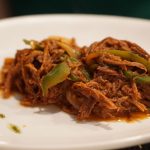Cuban cuisine
Traditional flavours, street food & sweets
Traditional flavours, street food & sweets
Cuba's gastronomic excursions are set to Latin American, Spanish and African rhythms with an exotic Caribbean breeze.
Cuban cuisine
Falling in love with a country goes (also) through the stomach and in Cuba's case it goes by the name of "comida criolla" - a mishmash of flavours from the cuisines of the countries that have left their mark on the identity of the largest Caribbean island. Many small dishes are served at the same time and mostly involve meat-based recipes (beef, pork or chicken) accompanied by rice, beans and vegetables or bulbs, which are in abundance.
Cuba's national dish is considered to be "Ropa vieja" ("old clothes" in Spanish) which is nothing more than beef with peppers, rice and baked beans. Also very popular are: 'moroz y cristianos' (moroz and Christians) or, in the vernacular, 'congrís', rice and black beans, while 'platano' is a common type of banana served in various ways: fried ('tostones'), as chips ('chicharritas') or boiled ('fufu de platano') - since it was the main food of the slaves.
The traditional dishes include: "ajiaco" (stew with pork or chicken and vegetables), "tasaho" (dried beef with spices), etc. If, however, the location has whetted your appetite for seafood and the island's sought-after grilled lobster ('langosta grille'), you will probably have to order them.
Hydration with exotic flavours
On the contrary, tropical fruits - mango, papaya, avocado, pineapple, coconut, etc, are not missing from any table, they are usually used at breakfast and enriched with their unknown "brothers" "mamey" and "guanabana", which are also transformed into amazing smoothies. The soft drinks category is dominated by homemade lemonades and guarapo, a sparkling drink made from sugar cane, together with batidos de guayaba (guava milkshakes), which are usually sold in stalls.
Restaurants & paladares
As far as eating places are concerned, there are now two main options: the state restaurants and the "paladares", the family restaurants that serve their goodies on the pavements or in the courtyards - of the households that run them - an activity that was put in place by Fidel Castro in 1992. For many, this is the most appropriate option, as it is considered more imaginative and, because it is based on competition, it presents a greater variety of flavours to the customer.
street food
As you will notice on your walks, street food in Cuba is a chapter in itself. As an absolute snack, "hamburguesa de cerdo" (hamburgers with pork burger), the classic Cuban sandwiches or "fritas" with pork, onion and tomato dominate, the seafood version of the pan con minuta with fried fish, the Hawaiian pizza (with ham and pineapple), the fried or roasted corn ('elote'), or the hot roasted peanuts ('maní'). Among the hypoglycaemics, churros (fried dough sticks sprinkled with sugar or hot chocolate), pie de coco (coconut pie) or syrupy coconut balls ('dulces de coco'/'coquito acaramelados') are at the top of the list. Of course, you can enjoy them with authentic Cuban 'cafecito", or with the king of summer cocktails, mohito. And a tip for the end- in the majority of cases you pay cash.







